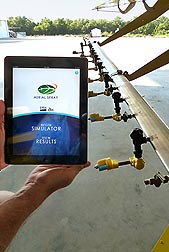Spraying Insecticide? There’s an App for That!
Applying pesticides is no simple task.With dozens of manufacturers producing dozens of different types of spray technology—each with its own nozzle type, flow rate, and pressure setting range—the equipment can get pretty complicated. Adjusting equipment to the right settings can involve factoring in wind speed, air temperature, flight speed, and humidity.
Agricultural Research Service scientists in Texas have released two new applications, or “apps,” to make things easier. The apps, developed by Brad Fritz and Clint Hoffmann, who are with the Areawide Pest Management Research Unit’s Aerial Application Technology group in College Station, will ensure that aerial and ground-based crews that spray pesticides have the best guidance possible before they spray. Users key in specifics on the type of equipment and pesticide they are using. The app displays the droplet size that will result from that setup and allows users to tweak settings to generate the desired droplet size.
The apps are designed to tap into the increasing use of smartphones and tablets. The National Agricultural Aviation Association found that more than half of the aerial applicators who responded to a recent survey reported using smartphones as their primary mobile device. The survey found an even split between Androids and iPhones, and the apps can be used on either device, Fritz says. “We have all this good data available, and we wanted to provide a convenient, easy-to-use platform that provides the data to the applicators who need it,” he says.
The apps incorporate the latest science of spray technology, including “spray nozzle atomization” models developed by ARS at College Station. The apps can be accessed from the field or from the cabin of a small aircraft, and they allow users to save data for later use or e-mail it to colleagues.
One app is designed for ground-based spraying for mosquitoes and other threats to public health. It covers 60 different sprayers made by 19 manufacturers and was developed jointly with the U.S. Department of Defense’s Navy Entomology Center of Excellence in Jacksonville, Florida. The ultra-low-volume sprayers and foggers range from hand-held and backpack types to ones mounted on all-terrain vehicles and trucks.
This public-health project was funded by the Deployed War-Fighter Protection program, which is administered by the Armed Forces Pest Management Board. The board funds ARS efforts to develop methods to protect military personnel from insect-transmitted diseases. (See story on "DWFP: A Battle Plan To Protect U.S. Troops From Harmful Insects" in this issue.)
The aerial spray app walks users through the process of adjusting nozzles and settings. The user specifies the nozzle manufacturer from a menu and is then steered through a series of screens and prompts. Based on the specific operating conditions, the app helps the user select the right size nozzle opening, spray pressure, nozzle orientation, and airspeed so that pesticides are delivered at the desired droplet sizes. Droplet size is critical in aerial operations to ensure accuracy, minimize pesticide drift, and ensure product label compliance with many agrochemical products. The app includes data on 10 fixed-wing spray nozzles and 8 rotary-wing nozzles. Fixed-wing models cover airspeeds from 100 to 160 mph, while rotary-wing models cover 30 to 100 mph.
The apps are available online through the Apple iTunes App Store and the Android Market by searching for “Aerial Sprays” for the aerial application app and “Vector Sprays” for the ground-based sprayer app.—By Dennis O'Brien, Agricultural Research Service Information Staff.
This research is part of Crop Protection and Quarantine (#304) and Crop Production (#305), two ARS national programs described at www.nps.ars.usda.gov.
To reach scientists mentioned in this article, contact Dennis O’Brien, USDA-ARS Information Staff, 5601 Sunnyside Ave., Beltsville, MD 20705-5129; (301) 504-1624.
"Spraying Insecticide? There’s an App for That!" was published in the November/December 2012 issue of Agricultural Research magazine.







